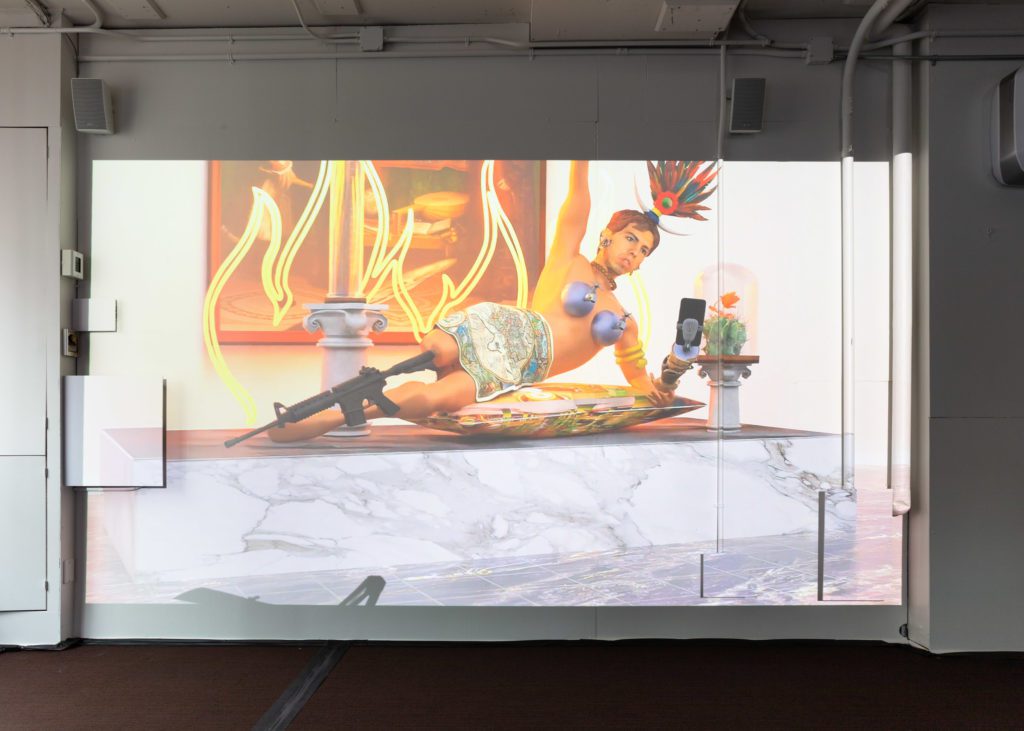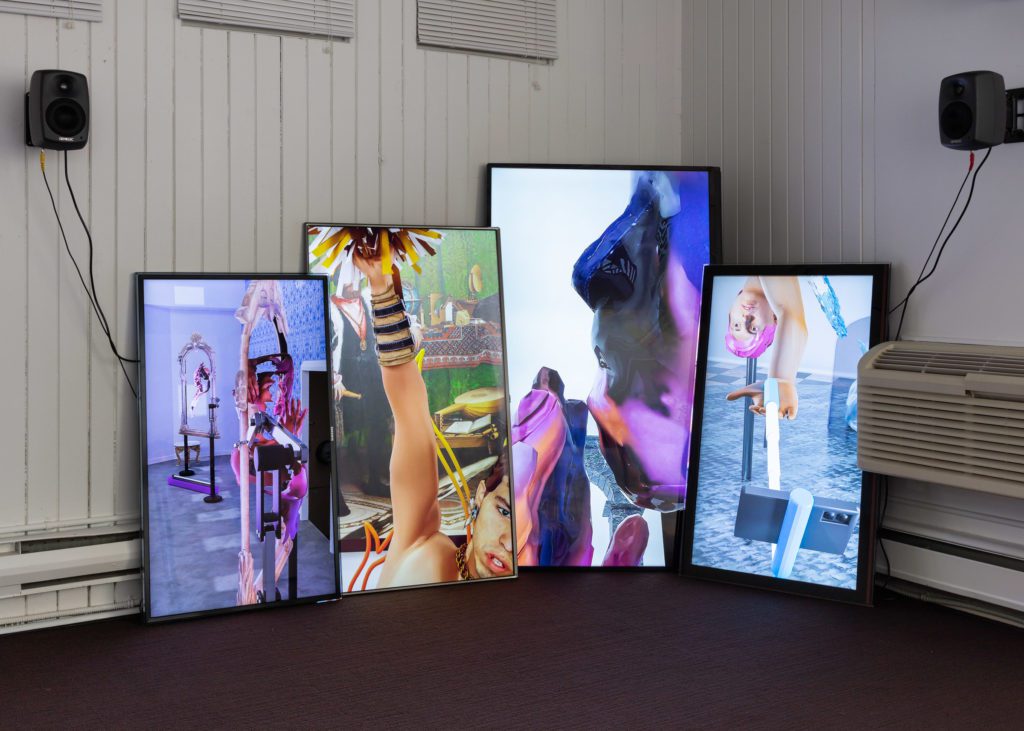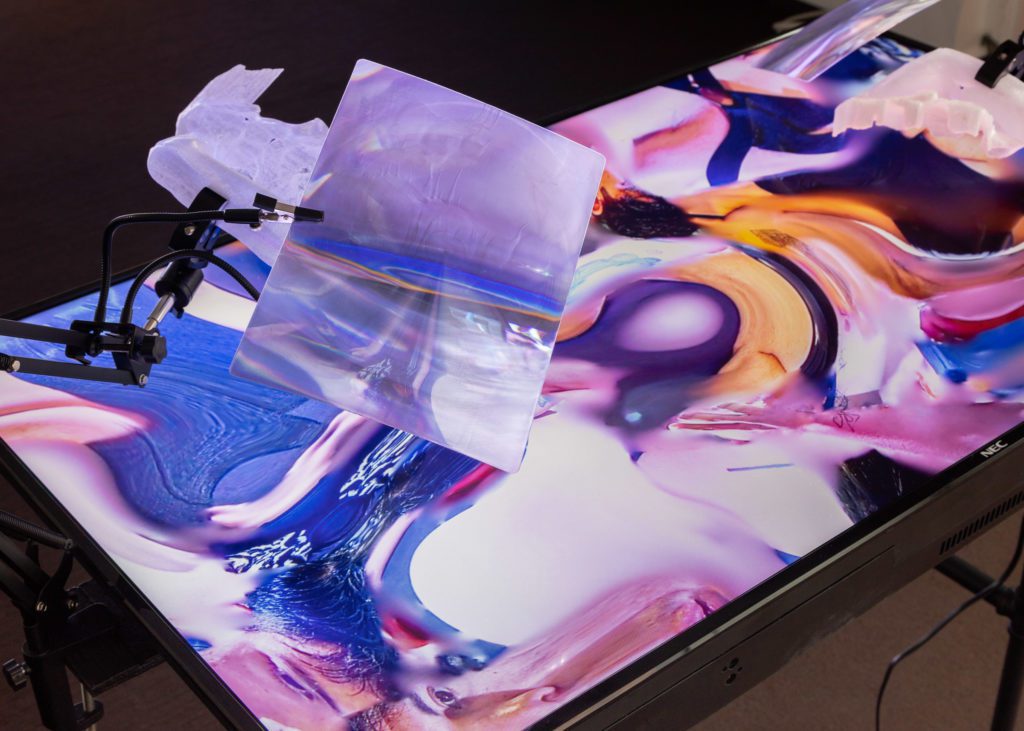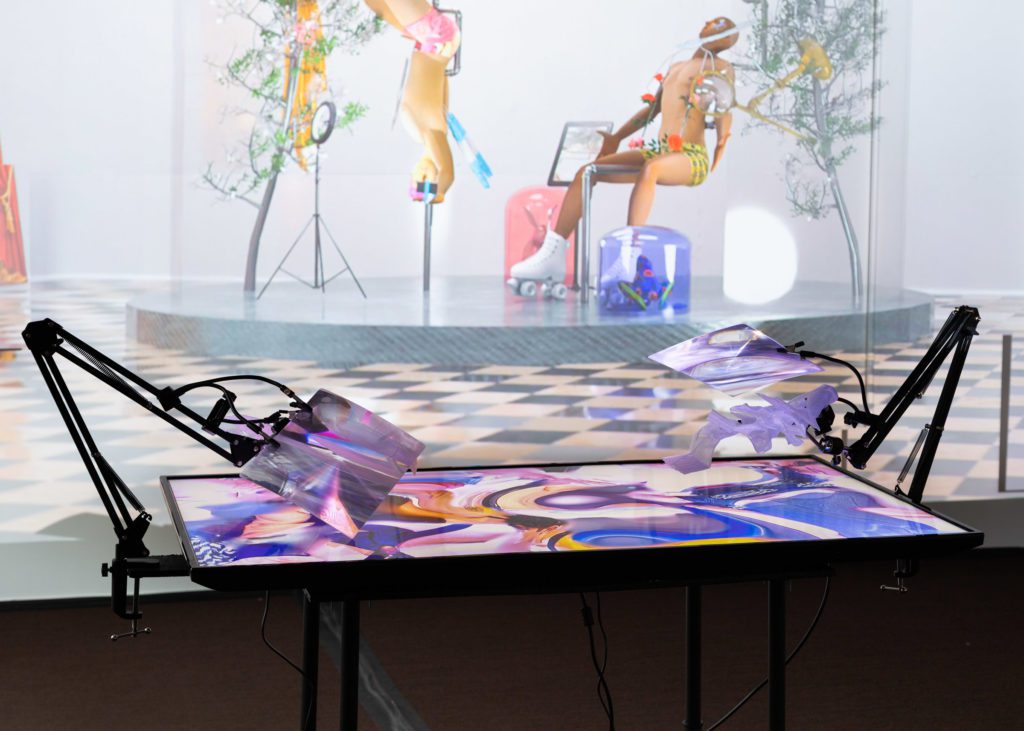Scanning Slippages & Copy/Pasted Identities
2 April 2023By Sophia Oppel

The museum of the copy/pasted identities, a solo exhibition by Francisco González-Rosas, was hosted by The Centre for Culture and Technology at the University of Toronto, where González-Rosas was the Centre’s inaugural artist-in-residence in the fall of 2022. Currently based in Montréal, González-Rosas is a Chilean-born performance and new media artist, whose work engages with technology as both an extension of, and witness to, corporeality. Formerly the office of media scholar Marshall McLuhan, the old coach house on the university’s campus offered an unconventional location for an exhibition that re-stages itself in a museum setting.
A 3D scan of the artist’s body, produced using photogrammetry, serves as the starting point to explore fractured modes of subject formation within the intangible space of the digital. Photogrammetric processes are tied to histories of map-making, land surveying, and aerial drone imaging, while 3D body scanning has securitized applications in airports and prisons. Within these highly surveilled settings, 3D scanners and low-level X-rays are often equipped with AI technologies trained using neural networks,1 which analyze a body against a binary-gendered form to determine if the body’s topography contains any contours the algorithm might deem “suspicious.”2 In this way, the real violence of biometric capture lies in its ability to measure a body against a normate or “ideal scale”3 as determined by the technology’s creator. Biometric capture thus renders a body legible using technological processes that remain opaque to the average person.
In “A Manifesto for the Broken Machine,” feminist media scholar Sarah Sharma posits the potential of technological malfunction as a site of feminist refusal—a possibility of leveraging mechanical failure to resist technology as an extension of current power dynamics.4 Deploying 3D scanning technologies as both material and subject, González-Rosas renders this typically opaque process visible as a medium, including its gaps and slippages. During an accompanying artist talk, González-Rosas noted the importance of the technological apparatus as a process: something with its own logic that can be borrowed, bent, and inverted. The artist’s self-reflexive use of 3D scanning and rendering tools opens up possibilities for a space outside the dominant, reductive, and surveillant potential of these technologies, wherein the seams in algorithmic tools become sites of poetic contingency.

A “copy/paste” identity assumes something that is infinitely re-combinable: a self that is not static, singular, or knowable in its entirety. The exhibition’s central video work, _the.museum (2022), features a multitude of computer-generated avatars of the artist, displayed like artefacts in a museum. These multifarious identities, presented across all of González-Rosas’ video works, oscillate between legibility and obscurity. The artist uses a variety of digital applications to create computer-generated facsimiles, some of which produce a 3D scan, while others simply texture map an image of the artist’s face onto a generic avatar body. Some of the bodies in the museum exist as flawed 3D scans—collections of algorithmically generated polygons or grotesquely stitched-together bodies full of holes. Sometimes the textures themselves are intentionally applied unevenly, revealing the ways that texture mapping is applied to a 3D-scanned model. When seen as a JPEG, the textures associated with 3D forms often resemble forensic grids: geometric nets that parse a 3D form into a 2D image of its polygons. Imagine a body, unspooled like a roll of film, indexed in small pieces. In Gonzalez-Rosas’s video, one figure’s texture continually shifts, stretching and contracting across the swell of an arm or a cavernous eye socket. Keeping the interpretational gaps of the 3D scanning software intact, these bodies point to the subtle inconsistencies of a self that can never be captured or reduced by biometric technologies, using the visual evidence of a poorly stitched algorithm to point to a digital alternative.
Leaning against the exhibition room’s back wall, four large monitors are arranged vertically in a staggered cluster. This constellation of screens, titled _identity.landscape (2022), features the same imagery as the larger single-channel video in episodic variations and non-linear parallels. Similar to _the.museum (2022), the movement of the point-of-view camera guiding the viewer through these videos is notably disorienting. This unevenness troubles the slick, late-capitalist drone tours of new condominiums associated with computer-generated architectural models. At times, the cameras zoom in uncomfortably close to the bodies, offering us a perspective we could not have in a real museum, where objects are often behind glass. The agency of the camera’s virtual gaze contrasts the algorithmic vision used to produce the identities, obfuscating these catalogued specimens. While the smaller TVs allow us a closer, more invasive look at these bodies than the larger projection does, the representations they encircle are similarly ungraspable.

Each of the characters in the museum gesture towards a hyper-legibility within the visual vocabulary of their display. The tableaus reference an anthropological museum, retrofitted with clinical filters and lenses reminiscent of both a doctor’s examination tools, and the familiar self-surveillant accessories of selfie-sticks, lighting mounts and tripods. One of González-Rosas’ central displays references the restaging of Frida Kahlo’s The Two Fridas (1939) by Chilean art collective Yeguas Del Apocalipsis in 1989 as a photograph. During a studio visit, González-Rosas noted their interest in continuing this art historical lineage centering queer South American artists, and the mediation intrinsic in re-staging a re-staging. However, to say this exhibition centres on the artist inserting themselves into the re-creation of Westernized museological space to disrupt it would be a simplification. In doing so, the artist’s self-representations also refuse the cultural reduction that is normalized and perpetuated by museological institutions and biometric technologies alike.
In this way, the artefacts created by a biased algorithm, and the museological artefacts that constitute Western colonial institutions are placed in parallel, perhaps gesturing towards the limiting nature of seeking transparency through datafication and categorization. One tableau features the artist flanked by two Indigenous Peruvian sculptures with the words “please don’t discover me” scrawled across their chest, referencing the colonial history of looting cultural artefacts for Western museums. Rather than being rendered totally legible and transparent, a strategy that Edouard Glissant argues is central to Western ways of knowing,5 the objects presented in this museum are not accompanied by plaques, QR codes, or other didactic explanations.

In the process of recombination, the viewer is not left with a singular model that these personas may be easily reduced to, but rather a glitched identity as one that, in line with Legacy Russel’s Glitch Feminism, “can at once be hypervisible and simultaneously unreadable, undetectable.”6 Gonzalez-Rosas’ intentionally glitched figures point to a refusal to be completely catalogued by surveillant technologies, and a desire to instead highlight the points of malfunction in 3D scanning applications. Rather than a collection of streamlined, measurable bodies reproduced by digital technologies, Gonzalez-Rosas’ collection of faulty avatars inhabit a site of algorithmic slippage, and gesture towards a strategy of technological misuse and mediation, where a body is not reducible, even in plain sight.
- Hexwave System: product page
- Sasha Costanza Chock, “Design Justice, A.I., and Escape from the Matrix of Domination,” Journal of Design and Science (Cambridge: MIT Press, 2018).
- Edouard Glissant, Poetics of Relation (Ann Arbour: University of Michigan Press, 1997), 190.
- Sarah Sharma, “A Manifesto for the Broken Machine,” Camera Obscura 104, vol. 35, no. 2, (2020), 171-179.
- Ibid.
- Legacy Russell, Glitch Feminism: A Manifesto (Brooklyn: Verso Books, 2020), 85.
The museum of the copy/pasted identities by Francisco González-Rosas ran from September 14 – October 15, 2022, at The Centre for Culture and Technology at the University of Toronto, ON.
Feature Image: Installation view of The museum of the copy/pasted identities, 2022, by Francisco González-Rosas. Courtesy of The Centre for Culture and Technology – University of Toronto. Photo by LF Documentation.



